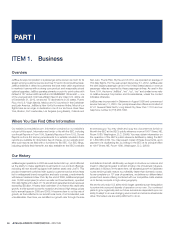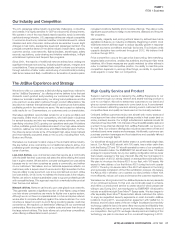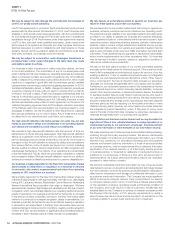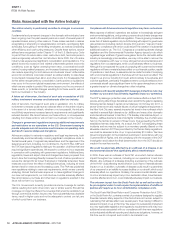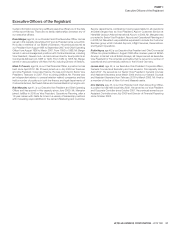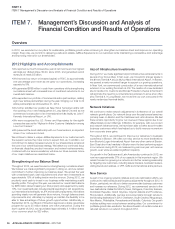JetBlue Airlines 2012 Annual Report Download - page 20
Download and view the complete annual report
Please find page 20 of the 2012 JetBlue Airlines annual report below. You can navigate through the pages in the report by either clicking on the pages listed below, or by using the keyword search tool below to find specific information within the annual report.JETBLUE AIRWAYS CORPORATION-2012 10K16
PART I
ITEM1ARisk Factors
We may be subject to risks through the commitments and business of
LiveTV, our wholly-owned subsidiary.
LiveTV has agreements to provide in-fl ight entertainment products and
services with six other airlines. At December31, 2012, LiveTV services were
available on 439 aircraft under these agreements, with fi rm commitments
for 219 additional aircraft through 2015 and with options for 52 additional
installations through 2014. Performance under these agreements requires
LiveTV to hire, train and retain qualifi ed employees, obtain component
parts unique to its systems and services from their suppliers and secure
facilities necessary to perform installations and maintenance on those
systems. Should LiveTV be unable to satisfy its commitments under these
third party contracts, our business could be harmed.
We may be subject to unionization, work stoppages, slowdowns or
increased labor costs; recent changes to the labor laws may make
unionization easier to achieve.
Our business is labor intensive and, unlike most other airlines, we have
a non-union workforce. The unionization of any of our employees could
result in demands that may increase our operating expenses and adversely
affect our fi nancial condition and results of operations. Any of the different
crafts or classes of our employees could unionize at any time, which would
require us to negotiate in good faith with the employee group’s certifi ed
representative concerning a collective bargaining agreement. In 2010,
the National Mediation Board, or NMB, changed its election procedures
to permit a majority of those voting to elect to unionize (from a majority
of those in the craft or class). These rule changes fundamentally alter the
manner in which labor groups have been able to organize in our industry
since the inception of the Railway Labor Act. Ultimately, if we and a newly
elected representative were unable to reach agreement on the terms of a
collective bargaining agreement and all of the dispute resolution processes
of the Railway Labor Act were exhausted, we could be subject to work
stoppages. In addition, we may be subject to other disruptions by organized
labor groups protesting our non-union status. Any of these events would
be disruptive to our operations and could harm our business.
Our high aircraft utilization rate helps us keep our costs low, but also
makes us vulnerable to delays and cancellations in our operating regions;
such delays and cancellations could reduce our profi tability.
We maintain a high daily aircraft utilization rate (the amount of time our
aircraft spend in the air carrying passengers). High daily aircraft utilization
allows us to generate more revenue from our aircraft and is achieved in
part by reducing turnaround times at airports so we can fl y more hours on
average in a day. Aircraft utilization is reduced by delays and cancellations
from various factors, many of which are beyond our control, including
adverse weather conditions, security requirements, air traffi c congestion and
unscheduled maintenance. The majority of our operations are concentrated
in the Northeast and Florida, which are particularly vulnerable to weather
and congestion delays. Reduced aircraft utilization may limit our ability to
achieve and maintain profi tability as well as lead to customer dissatisfaction.
Our business is highly dependent on the New York metropolitan market
and increases in competition or congestion or a reduction in demand
for air travel in this market, or governmental reduction of our operating
capacity at JFK, would harm our business.
We are highly dependent on the New York metropolitan market where we
maintain a large presence with approximately one-half of our daily fl ights
having JFK, LaGuardia, Newark, Westchester County Airport or Newburgh’s
Stewart International Airport as either their origin or destination. We have
experienced an increase in fl ight delays and cancellations at JFK due to airport
congestion which has adversely affected our operating performance and
results of operations. Our business could be further harmed by an increase
in the amount of direct competition we face in the New York metropolitan
market or by continued or increased congestion, delays or cancellations. Our
business would also be harmed by any circumstances causing a reduction
in demand for air transportation in the New York metropolitan area, such as
adverse changes in local economic conditions, negative public perception
of New York City, terrorist attacks or signifi cant price increases linked to
increases in airport access costs and fees imposed on passengers.
We rely heavily on automated systems to operate our business; any
failure of these systems could harm our business.
We are dependent on automated systems and technology to operate our
business, enhance customer service and achieve low operating costs.
The performance and reliability of our automated systems and data center
is critical to our ability to operate our business and compete effectively.
These systems include our computerized airline reservation system, fl ight
operations system, telecommunications systems, website, maintenance
systems, check-in kiosks, in-fl ight entertainment systems and our primary
and redundant data centers. Our website and reservation system must be
able to accommodate a high volume of traffi c and deliver important fl ight
information. These systems require upgrades or replacement periodically,
which involve implementation and other operational risks. Our business
may be harmed if we fail to operate, replace or upgrade our systems or
data center infrastructure successfully.
We rely on the third party providers of our current automated systems
and data center infrastructure for technical support. If the current provider
were to fail to adequately provide technical support for any one of our key
existing systems or if new or updated components were not integrated
smoothly, we could experience service disruptions, which, if they were to
occur, could result in the loss of important data, increase our expenses,
decrease our revenues and generally harm our business and reputation.
Furthermore, our automated systems cannot be completely protected
against events beyond our control, including natural disasters, computer
viruses, other security breaches, or telecommunications failures. Substantial
or sustained system failures could impact customer service and result in
our customers purchasing tickets from other airlines. We have implemented
security measures and change control procedures and have disaster
recovery plans as well as requiring our third party providers to have
disaster recovery plans; however, we cannot assure you these measures
are adequate to prevent disruptions, which, if they were to occur, could
result in the loss of important data, increase our expenses, decrease our
revenues and generally harm our business and reputation.
Our reputation and business may be harmed and we may be subject to
legal claims if there is loss, unlawful disclosure or misappropriation of, or
unsanctioned access to, our customers’, employees’, business partners’
or our own information or other breaches of our information security.
We make extensive use of online services and centralized data processing,
including through third party service providers. The secure maintenance
and transmission of customer and employee information is a critical
element of our operations. Our information technology and other systems
maintain and transmit customer information, or those of service providers
or business partners, may be compromised by a malicious third party
penetration of our network security, or of a third party service provider
or business partner, or impacted by deliberate or inadvertent actions or
inactions by our employees, or those of a third party service provider or
business partner. As a result, personal information may be lost, disclosed,
accessed or taken without consent.
We transmit confi dential credit card information by way of secure private
retail networks and rely on encryption and authentication technology licensed
from third parties to provide the security and authentication necessary to
effect secure transmission and storage of confi dential information, such
as customer credit card information. The Company has made signifi cant
efforts to secure its computer network. If any compromise of our security
or computer network were to occur, it could have a material adverse effect
on the reputation, business, operating results and fi nancial condition of
the Company, and could result in a loss of customers. Additionally, any
material failure by the Company to achieve or maintain compliance with
the Payment Card Industry, or PCI, security requirements or rectify a
security issue may result in fi nes and the imposition of restrictions on the
Company’s ability to accept credit cards as a form of payment.


